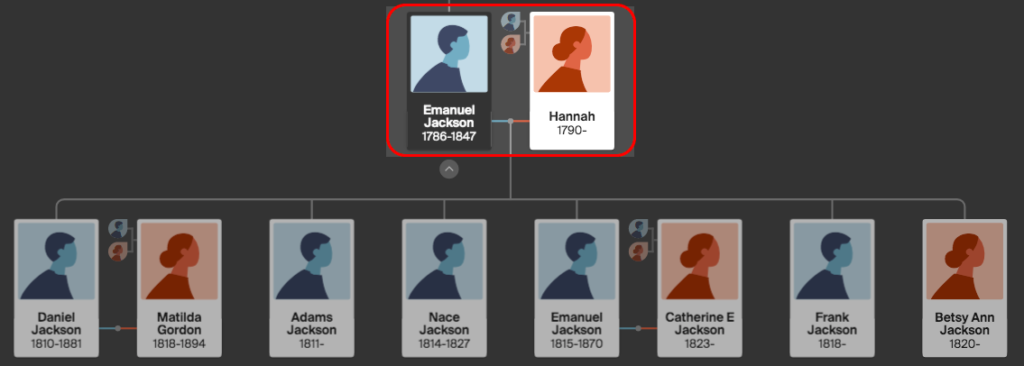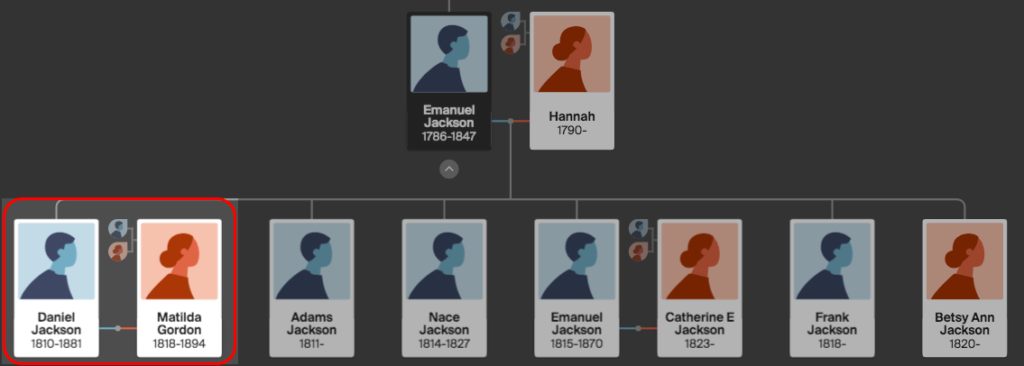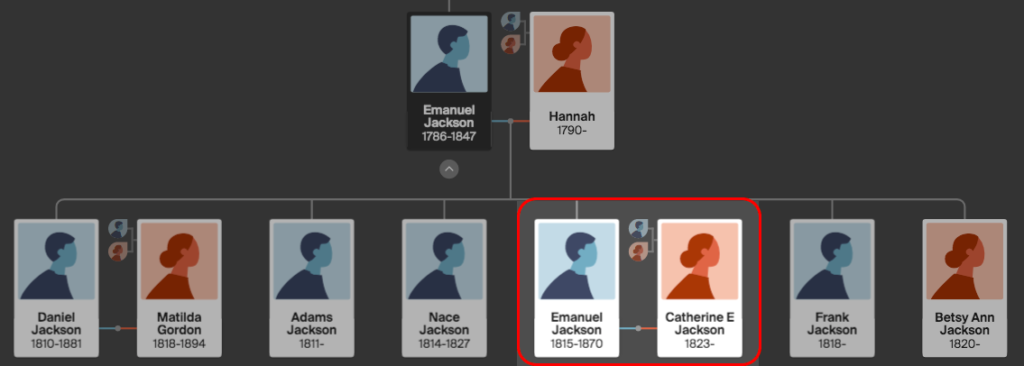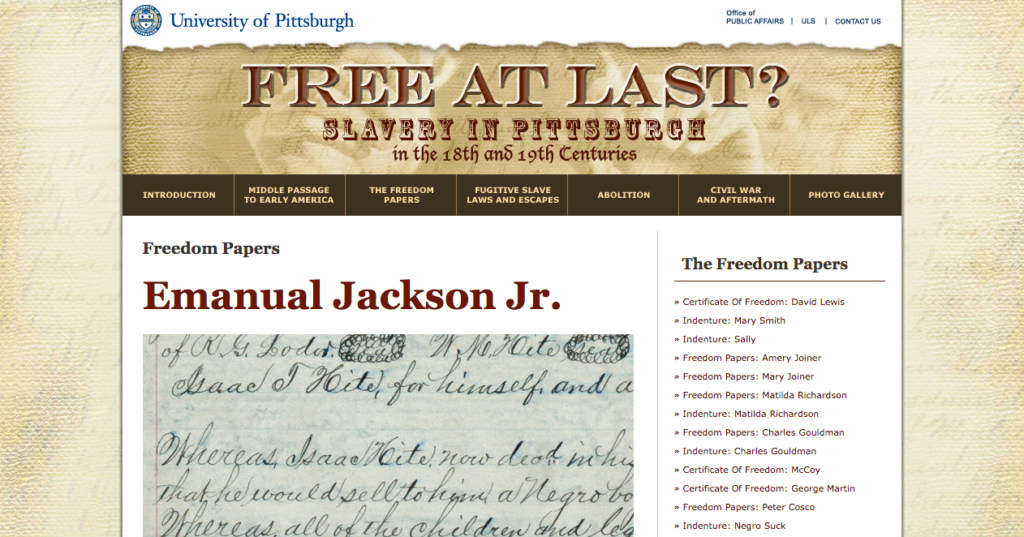A Story of Resilience & The Enduring Love of Family
Know all men by these presents that I Emanual Jackson, of the Town of Birmingham, in the County of Allegheny and State of Pennsylvania, but formerly of Frederick County, in the State of Virginia, from motives of parental affection, have manumitted and set free, and do hereby manumit and set free from slavery, my son Emanual.
Emanuel Jackson, 2 February 18411
Digital history is a powerful tool, taking local documents and sharing them with a global audience. In doing so, stories become more robust, history becomes clearer, and connections become more transparent.
Historians at Belle Grove discovered a project at the University of Pittsburgh called Free at Last? with a section called The Freedom Papers, which is a digital collection of legal papers from 1792 to 1857 that involve or include enslaved persons, free African Americans, emancipated enslaved persons, and/or indentures. Of note to Belle Grove was an entry for Emanuel Jackson Jr., which transcribes the purchase history of his freedom between his father, who is also named Emanuel Jackson, and Major Isaac Hite’s heirs, including Ann Tunstall Maury Hite.
This digital discovery on the Jackson family opened up research paths that historians are continuing to explore to this day. The story that follows shows one family’s unparalleled resilience, tremendous tenacity, and the enduring power of love.
The Jacksons at Belle Grove Plantation
A quick note
There are a lot of namesakes, so to avoid confusion, each person with a namesake has their birth year in parenthesis.
The Jackson family story starts in the early 1800s with Emanuel Jackson (1786), a free African American; Hannah Thornton, an enslaved woman at Belle Grove; and their six enslaved children – five sons and one daughter.
This exhibit begins to tell the Jackson family story, sharing what we know, but more importantly, sharing what we don’t know but hope to find out with more research.
Meet the Jacksons

We begin with Emanuel (1786) and Hannah. Read how historians think that they met and how Emanuel freed not only himself but also most of his family from enslavement.

Daniel (1810) and Matilda Gordon started their relationship and their family in enslavement, but their story doesn’t end there. They, too, were freed by Daniel’s father, Emanuel, and moved to Pittsburgh where he delved into the family’s teamster trade.

The Freedom Papers for Emanuel (1815) set historians down a research path that revealed his family’s incredible journey from enslavement to freedom. Emanuel married Catharine in Pennsylvania, and together they started a family, built a life, and amassed an incredible amount of wealth.

Adams, Nace, Frank, & Betsy Ann
Adams, Nace, Frank, and Betsy Ann are four of Emanuel and Hannah‘s children, all born into enslavement at Belle Grove. Only Frank and Betsy Ann saw their freedom; Nace died, and Adams was sold. We’re still researching to get a better understanding of their lives.
Learning Activities
With so many historical records being digitized, everyone can be their family’s genealogist! This activity encourages students to start with their immediate family members and see how much of their family tree that they can build using everything from local to online archives.
The Fugitive Slave Act of 1850 permitted the federal government to return any enslaved persons to their enslavers, even if they were found in a free state. PBS put together a lesson for students in grades 6-12 that uses their series, Mercer Street, to teach about the Fugitive Slave Act of 1850.
The Jackson Family project started with one document that has since opened up paths for additional research that historians are still exploring. In this activity, students use the tactics that historians at Belle Grove used to find the Jackson family.
- Emanual Jackson Jr.. Free at Last? Slavery in Pittsburgh in the 18th and 19th Centuries. (n.d.). Retrieved December 10, 2022, from http://exhibit.library.pitt.edu/freeatlast/papers/fp_emanualjacksonjr.html
- The image of Emanuel’s name is from Isaac Hite Jr.’s Commonplace Book, Virginia Museum of History and Culture (Mss5.5.H67375.1_19b).
- The image of Hannah’s name is from Isaac Hite Jr.’s Commonplace Book, Virginia Museum of History and Culture (Mss5.5.H67375.1_19b).
- Emanual Jackson Jr.. Free at Last? Slavery in Pittsburgh in the 18th and 19th Centuries. (n.d.). Retrieved December 10, 2022, from http://exhibit.library.pitt.edu/freeatlast/papers/fp_emanualjacksonjr.html
Acknowledgements
Funding for this research and exhibit was made possible through a Racial Justice Mini Grant of the Interpretation and Education Fund of the National Trust for Historic Preservation (funded by the National Endowment for the Humanities), Crescent Cities Charities, and the John H. Adamson III Memorial Fund. Special thanks to researchers Amy E.K. Arner of Arner Research in Pittsburgh, Pennsylvania, Dr. H. Wayne Sulfridge, Robin Young, Dr. Matthew Greer, Richard Schoener, Shannon Moeck, Kristen Laise, Lucinda Lentz, Jane Ailes, and Jessica Pritchard-Ritter.


